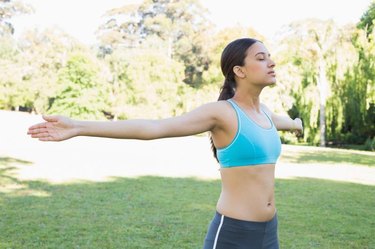
Shoulder popping or clicking can be caused by arthritis, rotator cuff injuries, impingement or even a tear. The following shoulder exercises will strengthen the rotator cuff and scapula. Over time, they may improve your flexibility and range of motion, so you may want to try them out.
Causes of Shoulder Popping
Video of the Day
If you experience occasional shoulder popping or clicking but no pain, then it's probably nothing to be worried about, says the Cleveland Clinic. However, if you also feel pain along with the shoulder pops, you may have an injury that needs to be evaluated by a doctor.
Video of the Day
As you age, the cartilage that cushions the joints starts to wear away, resulting in rougher surfaces. This may cause clicking or popping. Over time, it may progress to arthritis, a degenerative disorder that causes pain and stiffness. The most common type of arthritis in the shoulder is osteoarthritis or "wear-and-tear" arthritis, says the American Academy of Orthopaedic Surgeons (AAOS).
Shoulder clicking when raising an arm, along with locking, pain and a feeling of instability could also indicate a glenoid labrum tear, says the AAOS. People who have fallen on an outstretched arm or had a direct blow to the shoulder, as well as throwing athletes, can injure the tissue rim surrounding the shoulder socket, resulting in this type of injury.
Rotator cuff tendonitis, bursitis and impingement are other conditions that may cause shoulder popping. Make sure you see your doctor so he can determine the exact cause. Some shoulder injuries require surgery, while others can be treated with anti-inflammatory drugs and shoulder strengthening exercises.
1. Rotator Cuff Shoulder Clicking Exercises
Certain exercises can strengthen the rotator cuff muscles supporting your shoulder and maintain your range of motion. To stay safe, talk to your doctor before starting an exercise program.
Warm up for five to 10 minutes on the treadmill or stationary bike before getting started. Next, try the following exercises for shoulder stretching and strengthening, as recommended by the University of Wisconsin.
Move 1: Wall Climbing
- Face a wall with your arm straight.
- Walk the fingers of your injured arm up the wall.
- Keep your shoulder down and don't let it shrug up.
- Go as high as you can to improve and maintain your range of motion.
- Hold for 30 seconds and then walk your fingers back down.
- Repeat two to four times, trying to climb higher each time.
Move 2: External Rotator Strengthening
- Tie an exercise band to a doorknob.
- Bend your elbow to 90 degrees and hold on to the band with your injured arm, with your body facing away from the door.
- Rotate the forearm away from your body, keeping your elbow and arm tucked into your body.
- The band should provide resistance as you rotate away.
- Repeat eight to 12 times.
Move 3: Internal Rotator Strengthening Exercise
- Tie an exercise band to a doorknob.
- Bend your elbow to 90 degrees and hold on to the band with your injured arm. Your body should be facing the door.
- Rotate your forearm toward your body as the band provides resistance. Slowly move it back to neutral.
- Step away from the door if you need more resistance or step in if you need less.
- Repeat eight to 12 times.
Read more: 5 Exercise to Do When Shoulder Pain Flares Up
2. Scapular Strengthening Exercises
In addition to rotator cuff strengthening exercises and stretches, it's important to strengthen the shoulder blade, or scapula, if you have shoulder popping, says the University of Wisconsin. These muscles work with the rotator cuff to ensure your shoulder moves correctly. Stop any exercise that causes pain.
Move 1: Scapular Exercise/Arm Reach
- Lie on your back with arms and elbows straight. Lift your arms without bending your shoulders.
- Reach as high as you can toward the sky, keeping your elbows straight.
- You should feel your shoulder blades raise off the floor.
- Relax and return to normal. Repeat eight to 12 times.
Move 2: Scapular Retraction/Rows
- Put an exercise band around a bedpost and grab each end at waist level height.
- With the band at shoulder level, pull it back as you squeeze your shoulder blades together.
- Step back further for more resistance or step closer for less.
- Return to the starting position and repeat eight to 12 times.
- Cleveland Clinic: "Snap, Crackle, Pop: What You Need to Know About Joint Noises"
- American Academy of Orthopaedic Surgeons: "Shoulder Pain and Common Shoulder Problems"
- Cleveland Clinic: "Rotator Cuff Tendonitis"
- American Academy of Orthopaedic Surgeons: "Shoulder Joint Tear (Glenoid Labrum Tear)"
- University of Wisconsin: "Rotator Cuff Problems: Exercises You Can Do at Home"